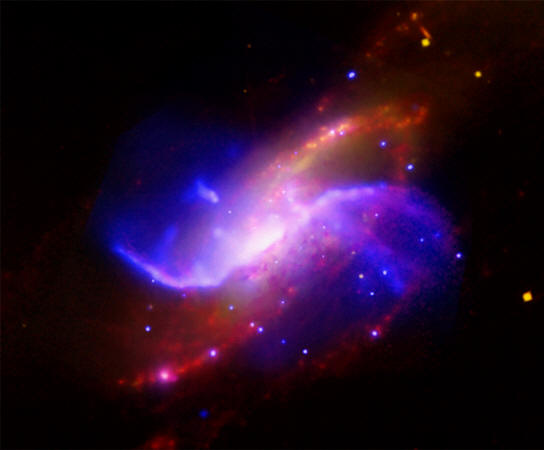|

Composite image of spiral
galaxy M106 (NGC 4258).
Credit: X-ray NASA/CXC/Univ. of
Maryland/A.S. Wilson et al.;
Optical: Pal.Obs. DSS; IR:
NASA/JPL-Caltech; VLA: NRAO/AUI/NSF
Electromagnetic Galaxies
Mar 17, 2011
Galactic magnetic fields were
discovered more than 50 years ago.
Astronomers continue to ask basic
questions about the stars: what
generates their magnetic fields?
What gives those fields their shape
and their strength?
According to a recent
press release, a team of
astronomers using an updated
analytical model of galaxy formation
think they have found the answers.
Cool gas falling into the galaxy,
supernovae explosions, the birth of
new stars, and the rotational energy
of the galaxy itself are what create
the fields. However, they are
missing other factors in their
equations since the models are not
able to predict the fields observed
in several spiral galaxies.
How do scientists observe
extrasolar magnetic fields? George
Ellery Hale first plotted the Sun's
magnetic field using the "Zeeman
effect," or the change in position
of Fraunhofer lines found in
spectrograms of the Sun. Optical
spectra indicate which chemicals can
be found in the Sun, as well as
other stars. By spreading starlight
into its components like a prism
does to white light, dark lines at
specific places provide a way to
determine a star's constituent
elements.
In the presence of a magnetic
field, elements produce spectral
lines that split and occupy
different positions. Those changes
in position are called the Zeeman
effect. However, as a paper written
by the investigation team states:
"Such fields are important in star
formation and the physics of cosmic
rays, and could also have an effect
on galaxy evolution, yet, despite
their importance, questions about
their origin, evolution and
structure remain largely unsolved."
It is not surprising that the
magnetic field contours surrounding
the stars that have been mapped, as
well as those seen around galaxies,
remain unexplained in the minds of
those who hold to a consensus
viewpoint. In the theoretical pool
of knowledge from which they draw,
there are no electrical entities to
provide the source for that
magnetism.
Instead, "star formation reducing
turbulent energy," "gas ejection,"
and "how fast ordered magnetic
fields arise from random ones" are
discussed. No electromagnetism, no
e-fields, and no motor-generator
effects are included in their
calculations.
Magnetic fields in space can be
detected more easily than electric
currents, so modern astronomers
think that the fields are
"primordial" fragments left over
from the Big Bang. They rely on that
conclusion to explain how the
structures that make up the Universe
were formed.
The fact that moving charges
constitute an electric current that
can generate magnetic fields has
been known since the days of
Michael Faraday. However,
a lack of knowledge often means a
lack of vision. As previously
stated, moving charged particles
constitute an electric current, and
that current is wrapped in a
magnetic field. When more charged
particles accelerate in the same
direction, the field gets stronger.
That is a familiar idea to
electrical engineers, but when
astronomers find moving charges in
space they are mystified and refer
to them as "winds," or "shock
waves."
Something else not considered
when researchers attempt to explain
structure in the Universe is that
for charged particles to move, they
must move in a circuit. Energetic
events cannot be explained by local
conditions, alone. The effects of an
entire circuit must be considered.
For that reason, while the consensus
scientific worldview only permits
isolated "islands" in space, the
Electric Universe emphasizes
connectivity with an electrically
active network of "transmission
lines" composed of Birkeland current
filaments.
Filaments expand and explode,
throwing off plasma that can
accelerate to near
light-speed. Jets from opposite
poles of a galaxy end in energetic
clouds emitting X-ray frequencies.
These phenomena are based in plasma
science and not gas kinetics,
gravity, or particle physics.
Astrophysicists see magnetic fields
but not the underlying electricity,
so they are at a loss to explain
them.
Astronomers maintain that
galaxies are clouds of hydrogen gas
and intergalactic dust that were
assembled by gravity until they
coalesced into glowing thermonuclear
fires. The conventional community
also proposes that most galaxies
contain black holes of unbelievable
magnitude. It is those
“gravitational point sources” that
cause the galaxies to spin, jets of
gamma and X-rays that span thousands
of light-years to appear, as well as
“radio lobes” sometimes larger than
the parent galaxy to form.
The Electric Universe theory does
not adhere to the idea of galaxies
condensing out of cold, inert
hydrogen and specks of zircon no
bigger than a molecule. So,
what are galaxies?
In 1981, Hannes Alfvén said that
galaxies are much like one of
Michael Faraday's inventions, the
homopolar motor. A homopolar motor
is driven by magnetic fields induced
in a circular conducting plate. The
plate is mounted between the poles
of an electromagnet, causing it to
spin at a rate proportional to the
input current.
Galaxies move within a
filamentary
circuit of electricity
that flows through the cosmos from
beginning to end. We see the effects
of those electromagnetic fields that
permeate space. Electricity
organizes itself within masses of
plasma sometimes larger than galaxy
clusters. That plasma is primarily
composed of neutral atoms, but free
electrons, protons and other charged
particles are also present.
Primal electrical energy is
orders of magnitude more powerful
than gravity. The “plasma
ropes” that comprise
Birkeland currents attract one
another over distance in a linear
relationship, so Birkeland currents
are the most powerful long-range
attractors in the Universe. Electric
currents flowing through dusty
plasma sustain the magnetic fields
detected in stars and galaxies.
Stephen Smith
|







